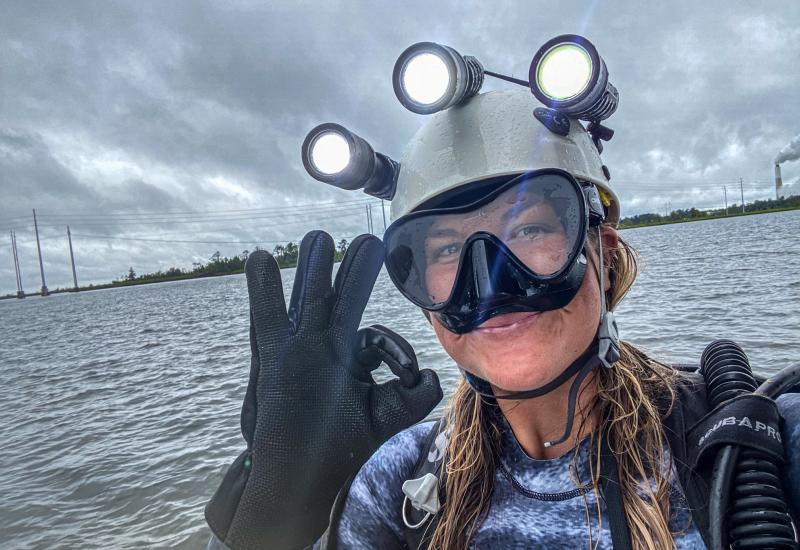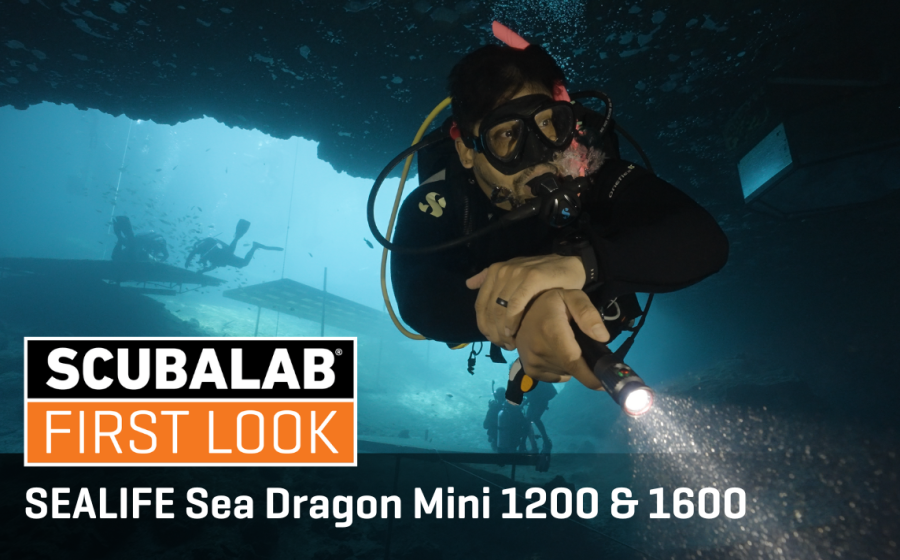The Best Deep Dives
WHY GO DEEP? Because — for those with the right skills and training — the rewards for pushing to recreational limits and beyond include sights and sensations the average diver will never know.

Jennifer PennerTree branches greet divers 120 feet down in the Pit.
It’s a thought that comes to all of us. Peering down a sheer wall or oil rig into the blue-black abyss, or listening to someone else’s account of a wreck that’s deeper than any we’ve done, the curiosity comes flooding in. Who doesn’t wonder what lies below — and what we’re missing? But with greater depth comes greater responsibility — you’ll need the appropriate training, gear, dive plan and mindset to go deeper. But once you’ve set the goal, you’ll open yourself to what’s possible in the last frontier on Earth.
1 ) HMS Southwold
MALTA
DEPTH RANGE: 220+ ft.
SKILLS: Wreck penetration, doubles (tanks), rebreather
WATER TEMP: 39° to 65°

Liz RogersA diver maneuvers through the stern section of the Southwold at a depth of 197 feet.
“It looks like it went down fighting,” says Alan Whitehead, owner of TechWise Malta, of the Type II Huntclass destroyer downed after hitting a mine. Its mission had been to assist a sinking merchant ship off the Mediterranean island in 1942. Now the Southwold lies more than 200 feet down, broken in two. Both halves remain intact, separated by some 900 feet of sand. The shallower stern is in roughly 220 feet of water, the bow between 230 and 246 feet.
Its resting grounds resemble a battlefield, with “guns and shells and depth charges — like big oil drums — everywhere,” says Whitehead.
Unlike many historical wrecks, this World War II casualty’s nameplate remains in place. So too do its 4-inch guns, still aimed skyward.
“It’s a bit messy around the ship and inside — it’s been down 70 years,” says Whitehead.
Even without penetrating, divers on doubles or rebreather can peer inside hatches on the bow and stern at machinery within. Beyond the metal and guts, the ship’s overhangs and crevices shelter legions of dusky grouper. And, several times a year, mola mola show up to feed on deepwater squid and jellyfish. For any diver trained to reach beyond 200 feet, it’s well worth the gas fills.
“As parts continue breaking away, it’s only getting more interesting as more inside is revealed,” Whitehead says.
2 ) Northern Light
KEY LARGO, USA
DEPTH RANGE: 140 to 180 ft.
SKILLS: Hot drop, negative entry, drift, deco stops
WATER TEMP: 70°
“The Northern Light is why I got into diving,” says Jeff Knapp, head instructor at Horizon Divers, a Key Largo-based scuba center and technical-diving training school. “I’ve always wanted to see the things that a lot of people will never get to see.”
The 300-foot Great Lakes freighter, now at 180 feet, is one such wreck. It’s 45 feet deeper than the much-hyped nearby Spiegel Grove, which sits in sand at 135 feet, just past recreational limits. The freighter’s depth alone limits the number of visiting divers, which Knapp estimates to be 100 annually.
Then there’s the added challenge of the hot drop — divers must descend with negative buoyancy to drift onto the wreck quickly, fast enough to avoid being swept away by unpredictable currents.
“A wreck that deep can have a current that’s doing something very different from what’s happening at the surface,” says Knapp. But landing on the target is the start of a tour that includes a rudder jutting straight up to 140 feet, then the windlass and a growth-covered bow.
“The depth of Northern Light gets your blood pumping,” Knapp says. “Add the hot drop and the drift deco, toss in the bull and reef sharks, the darker ambience and colder water of a deeper wreck, and you have an experience that’s completely different from what recreational divers know. You can’t help but feel special when you dive it.”
3 ) Eureka and Elly Oil Rigs
LOS ANGELES, USA
DEPTH RANGE: 100 feet and below, with Eureka reaching the sand at 720 feet, and Elly at 260 feet
SKILLS: Overhead environment, currents
WATER TEMP: 50° to 64°
The sponges, crabs and host of colorful life anchored to the Eureka and Elly oil rigs, 8½ miles from the palm-tree-studded shores of Los Angeles, aren’t thick and lush until depths past 60 feet.

Brook PetersonA bouquet of strawberry anemones (Corynactis californica) blankets one of the steel girders on the Eureka oil rig.
In shallower, sundrenched depths, sponges balloon to such great surface area that they are subjected to far more waves and swells, a liability to these working structures.
Their management companies must regularly employ pressure washers, says Jim Smith of Ventura Dive and Sport, “to protect the stability of the oil rig itself.” But drop down to 100 feet and lower, and there’s “life on top of life on top of life,” says underwater photographer Joe Platko.
Invertebrates like strawberry anemones, bright-yellow sponges, giant white-plumed metridium anemones, ochre sea stars and purple urchins have taken over, blooming like fields of wildflowers, and supporting swarms of baitfish such as anchovies. Moving up the food chain, these rigs also attract crimson sheepshead, orange garibaldi and blacksmiths as well as sea lions and mola mola. “Anything swimming through the area will be attracted to these oases,” Platko says.
The structures also act as jungle gyms for divers, allowing them to swim up and around supports that buzz with life, literally.
“The rig is humming because people are working on it,” says Platko. “You’re vibrating in the water alongside all these animals.”
4 ) The Pit
PLAYA DEL CARMEN, MEXICO
DEPTH RANGE: 120 to 400 ft.
SKILLS: Intro to Cave Diver to dive the main line; to traverse or see the whole cave, you would need Trimix and Full Cave Diver.
WATER TEMP: 68°

Mel ClarkPart of the excitement of the Pit comes from dropping deep into the Wakulla room, the colossal gut of the cenote.
Ask Gustavo Padilla, cave-diving instructor for Pro Dive International, what’s exciting to see 100 feet down in the Pit, a cenote an hour’s drive south of Playa del Carmen, and the answer might surprise you: “Not a lot.”
That’s because things don’t get good until 300 feet, just beyond the entrance to the Wakulla room at 289 feet. “It’s a milestone for many tec divers to even enter,” says Padilla of the space.
A narrow passage leads the way — and then everything opens up. The Wakulla room is massive. Regardless of which light you bring, it can’t illuminate enough real estate to get a sense of how epic the room is. Stalactites adorn the ceiling, and the floor is a series of rock hills and boulders the size of buses. Deeper still, at roughly 400 feet, the cave is famous for containing saber-toothed-tiger bones and human remains.
The other stop-you-in-your-fins moment happens when divers return to 120 feet, where a hydrogen sulfide band creates a milky divide. Here, a tree juts from the white haze.
“It feels like you’re flying over the trees and a cloud as you swim above this layer,” says Padilla.
At this depth, when divers glance back toward the cave’s entrance, they can appreciate the show created by beams of sunlight streaming through and hitting that sulfur layer.
“When it’s summer and it’s sunny, it goes from a really good dive to an unforgettable experience,” Padilla says.
5 ) Lighthouse Point Reef
GRAND CAYMAN, CAYMAN ISLANDS
DEPTH RANGE: 140 to 180 ft
SKILLS: Nitrox, rebreather or trimix; no current, DPV diving
WATER TEMP: 70s+
There’s a reason Grand Cayman continually tops tec divers’ destination lists: Few other places on the planet offer 4,000 feet of underwater vertical that’s a “10-minute leisurely swim from shore,” says Jo Mikutowicz, owner of the on-island scuba center Divetech.
Granted, even divers on rebreather and other tec setups aren’t pushing down a mile below the surface to reach the true bottom. Most target the 100-foot mark of the wall, known locally as the sponge belt. “This is where you start to see dozens of sponges bigger than I am,” says Mikutowicz.
Around this range, divers also will encounter a series of pinnacles starting at 95 feet and continuing to sprout from the depths at 140 and 150 feet.
Here, not only are the porifera prolific, but encounters with wildlife may also differ from typical.
“First I see the silhouette out in the blue, and they slowly, slowly get closer. Hammerheads are very curious and will come in close, but not in an aggressive way. Several times I’ve watched as a hammerhead shark nosed up within 2 feet of me,” says Mikutowicz. Not surprisingly, it’s happened when she was on rebreather. “But it’s also happened on open-circuit scuba,” she says.
Which is perhaps not all that unusual given that animals terrestrial and aquatic alter their routes when disturbed by throngs of traffic. And here along this deep stretch of wall off Lighthouse Point Reef, there’s no reason for them to divert course. Crowds are never an issue.
6 ) CJ’s Drop-Off
UTILA, HONDURAS
DEPTH RANGE: 250 to 300 ft.
SKILLS: Trimix, rebreather, cavern, deco
WATER TEMP: 78° to 84°
“It’s how I imagine the moon to be,” says Andy Phillips, director of professional training at Utila Dive Center, of CJ’s Drop-Off, found along the north side of the Honduran island.
Most recreational divers visiting for a week drop in on the spot but don’t pass 130 feet. They experience the weightlessness of the astronaut life, but they miss out on the scenery that completes the otherworldly experience.
The site is a sheer wall — “like the north face of a cliff,” says Phillips. Divers on trimix or rebreather can, at 250 feet, enter a cavern formed during the Ice Age when this stretch of reefscape was dry enough to allow a 9-foot-long stalactite to form.
Those plummeting farther, to 300 feet and beyond, find fields of big sand craters. At their edge lies another wall.
“You become very conscious of every breath as you look down, and it drops and drops,” Phillips says. Then it’s time to come up. Unlike dive sites where the ride up is nothing but blue water, here divers can enjoy the reef while decompressing.
Says Phillips, “Ascending is like transitioning from black-and-white TV to color as the light comes back.”
7 ) B-29 Superfortress
LAKE MEAD, USA
DEPTH RANGE: 115 TO 200 FT.
SKILLS: Cold-water diving
WATER TEMP: 50° to 64°

Mel ClarkA tec diver explores the cockpit of Lake Mead's B-29, largely intact since it crashed in 1948.
Storms, erosion and rising ocean levels have, with time, altered the depths of many wrecks, making them deeper targets.
Not so with the Boeing B-29 Superfortress, which crashed in the Overton Arm area of Lake Mead, Arizona, in 1948.
When Dave Conlin, chief archaeologist for the National Park Service’s Submerged Resources Center, first dived the plane more than a decade ago, he found it at a depth of around 200 feet.
But with the Colorado River — a government controlled, dammed source — feeding the lake, the water level has gotten shallower every year as the flow is siphoned off.
Now the plane sits at a depth of 115 feet, making it more accessible. Visitors must go with a licensed guide, such as Joel Silverstein with Tech Diving Limited. They’ll find a four-engine propeller plane — the same model as the one that bombed Hiroshima and Nagasaki, Japan, in WWII. Its propellers had been running at the moment of impact, bending the blades at right angles. But that seems to be the biggest damage incurred; the rest of the vessel, spanning 140 feet across, remains intact.
Says Conlin: “The tail is taller than a two-story building. To swim around this plane is awe-inspiring — it towers over you.”










